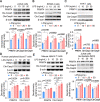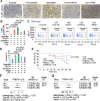Protein arginine N-methyltransferase 4 (PRMT4) contributes to lymphopenia in experimental sepsis
- PMID: 35354645
- PMCID: PMC9522923
- DOI: 10.1136/thoraxjnl-2021-217526
Protein arginine N-methyltransferase 4 (PRMT4) contributes to lymphopenia in experimental sepsis
Abstract
Background: One hallmark of sepsis is the reduced number of lymphocytes, termed lymphopenia, that occurs from decreased lymphocyte proliferation or increased cell death contributing to immune suppression. Histone modification enzymes regulate immunity by their epigenetic and non-epigenetic functions; however, the role of these enzymes in lymphopenia remains elusive.
Methods: We used molecular biological approaches to investigate the high expression and function of a chromatin modulator protein arginine N-methyltransferase 4 (PRMT4)/coactivator-associated arginine methyltransferase 1 in human samples from septic patients and cellular and animal septic models.
Results: We identified that PRMT4 is elevated systemically in septic patients and experimental sepsis. Gram-negative bacteria and their derived endotoxin lipopolysaccharide (LPS) increased PRMT4 in B and T lymphocytes and THP-1 monocytes. Single-cell RNA sequencing results indicate an increase of PRMT4 gene expression in activated T lymphocytes. Augmented PRMT4 is crucial for inducing lymphocyte apoptosis but not monocyte THP-1 cells. Ectopic expression of PRMT4 protein caused substantial lymphocyte death via caspase 3-mediated cell death signalling, and knockout of PRMT4 abolished LPS-mediated lymphocyte death. PRMT4 inhibition with a small molecule compound attenuated lymphocyte death in complementary models of sepsis.
Conclusions: These findings demonstrate a previously uncharacterised role of a key chromatin modulator in lymphocyte survival that may shed light on devising therapeutic modalities to lessen the severity of septic immunosuppression.
Keywords: ARDS; Bacterial Infection; Lymphocyte Biology; Pneumonia; Respiratory Infection.
© Author(s) (or their employer(s)) 2023. Re-use permitted under CC BY-NC. No commercial re-use. See rights and permissions. Published by BMJ.
Conflict of interest statement
Competing interests: None declared.
Figures







Similar articles
-
Endotoxin stabilizes protein arginine methyltransferase 4 (PRMT4) protein triggering death of lung epithelia.Cell Death Dis. 2021 Sep 3;12(9):828. doi: 10.1038/s41419-021-04115-7. Cell Death Dis. 2021. PMID: 34480022 Free PMC article.
-
PRMT4 is a novel coactivator of c-Myb-dependent transcription in haematopoietic cell lines.PLoS Genet. 2013;9(3):e1003343. doi: 10.1371/journal.pgen.1003343. Epub 2013 Mar 7. PLoS Genet. 2013. PMID: 23505388 Free PMC article.
-
PRMT4 overexpression aggravates cardiac remodeling following myocardial infarction by promoting cardiomyocyte apoptosis.Biochem Biophys Res Commun. 2019 Dec 10;520(3):645-650. doi: 10.1016/j.bbrc.2019.10.085. Epub 2019 Oct 16. Biochem Biophys Res Commun. 2019. PMID: 31627895
-
CARM1/PRMT4: Making Its Mark beyond Its Function as a Transcriptional Coactivator.Trends Cell Biol. 2021 May;31(5):402-417. doi: 10.1016/j.tcb.2020.12.010. Epub 2021 Jan 20. Trends Cell Biol. 2021. PMID: 33485722 Review.
-
Apoptosis-induced lymphopenia in sepsis and other severe injuries.Apoptosis. 2017 Feb;22(2):295-305. doi: 10.1007/s10495-016-1325-3. Apoptosis. 2017. PMID: 27812767 Review.
Cited by
-
Risk factors for prolonged infection and secondary infection in pediatric severe sepsis.Infection. 2025 Feb;53(1):241-251. doi: 10.1007/s15010-024-02355-1. Epub 2024 Aug 8. Infection. 2025. PMID: 39117931 Free PMC article.
-
Identification and exploration of novel biomarkers and potential therapeutic agents for the progression of sepsis to septic ARDS.Medicine (Baltimore). 2025 Aug 29;104(35):e44170. doi: 10.1097/MD.0000000000044170. Medicine (Baltimore). 2025. PMID: 40898483 Free PMC article.
-
Advancements in omics technologies: Molecular mechanisms of acute lung injury and acute respiratory distress syndrome (Review).Int J Mol Med. 2025 Mar;55(3):38. doi: 10.3892/ijmm.2024.5479. Epub 2025 Jan 3. Int J Mol Med. 2025. PMID: 39749711 Free PMC article. Review.
-
Epigenetic mechanisms of Immune remodeling in sepsis: targeting histone modification.Cell Death Dis. 2023 Feb 11;14(2):112. doi: 10.1038/s41419-023-05656-9. Cell Death Dis. 2023. PMID: 36774341 Free PMC article.
-
The Influence of Arginine Methylation in Immunity and Inflammation.J Inflamm Res. 2022 May 13;15:2939-2958. doi: 10.2147/JIR.S364190. eCollection 2022. J Inflamm Res. 2022. PMID: 35602664 Free PMC article. Review.
References
Publication types
MeSH terms
Substances
Grants and funding
- R01 HL142997/HL/NHLBI NIH HHS/United States
- R01 HL097376/HL/NHLBI NIH HHS/United States
- K24 HL143285/HL/NHLBI NIH HHS/United States
- R01 HL136143/HL/NHLBI NIH HHS/United States
- R01 HL125435/HL/NHLBI NIH HHS/United States
- R01 HL142084/HL/NHLBI NIH HHS/United States
- R01 HL149719/HL/NHLBI NIH HHS/United States
- R01 HL096376/HL/NHLBI NIH HHS/United States
- R01 HL081784/HL/NHLBI NIH HHS/United States
- R01 HL098174/HL/NHLBI NIH HHS/United States
- I01 CX001048/CX/CSRD VA/United States
- K23 HL139987/HL/NHLBI NIH HHS/United States
- I01 CX000105/CX/CSRD VA/United States
- P01 HL114453/HL/NHLBI NIH HHS/United States
LinkOut - more resources
Full Text Sources
Medical
Research Materials
